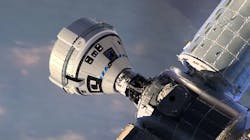Boeing’s Delayed Starliner Not Expected Ready Until March, With Actual Launch Date TBD
The two major fixes needed on Boeing’s CST-100 Starliner that the company announced with NASA back in June are well underway, but the spacecraft is not expected to be ready until March 2024 in its effort to finally complete its crewed test flight to the International Space Station.
“We’re going to do the right thing with respect to the safety of the vehicle, and that is first and foremost in every discussion that we have,” said Mark Nappi, who heads up Boeing’s Starliner program during a joint NASA-Boeing press conference on Monday.
The spacecraft has been lining up a potential July launch, but earlier this year, teams found a pair of issues that forced them to halt launch preparations. One involved the parachute system and a second involved flammable tape used on the wiring throughout the spacecraft.
It was yet another delay in what has been a tortuous path in the effort by Boeing to have Starliner join SpaceX’s Crew Dragon as one of two spacecraft assigned to bring NASA astronauts up to the ISS from the U.S. as part of the Commercial Crew Program. Boeing and SpaceX won the contracts back in 2016 and SpaceX made its first crewed test flight in May 2020.
SpaceX followed with its first operational flight later that year and has been the lone U.S-based launch provider for rotational crew missions ever since, now lining up its seventh operational mission as soon as Aug. 25.
The reliance on SpaceX was due to Boeing’s mishaps during its first uncrewed test flight in December 2019 when Starliner failed to rendezvous with the ISS. While the capsule did make it safely back to Earth, NASA dubbed the mission a “high visibility close call” that forced a major overhaul of the program including hardware, software and management practices from both Boeing and NASA oversight.
What followed was more than 2 1/2 years before Boeing finally was able to successfully complete the redo of the uncrewed test flight, which flew in May 2022.
NASA and Boeing then moved ahead with attempting to send up the Crew Flight Test (CFT) mission that looks to send NASA astronauts Suni Williams and Butch Wilmore for what is still planned to be about an eight-day stay. The parachute and tape issues, though, were revealed in June, and teams have since been working to correct them.
“A lot of work has been done. Both those topics are very well understood at this time,” Nappi said.
For the parachute system, it involved a set of links that did not meet the stress parameters after teams realized they had previously been tested incorrectly. Teams made the decision to replace the parachute system with a contractor that’s already performing testing. As far as the flammable tape, teams have been going into all the parts of Starliner and removing the tape where possible, but Nappi said there will be some places where they will have to use coatings or barriers that would remediate the threat of catching on fire.
Nappi said the flammable tape issue should be complete by September while he expects delivery of the new parachute system in early December.
“That new parachute is the critical path to delivery,” Nappi said.
At the same time this work is being done, both NASA and Boeing have assigned independent assessors of the spacecraft to give an extra layer of safety supervision. Their investigation will be reported up a different reporting structure before the Flight Readiness Review ahead of the CFT.
Nappi said the spacecraft won’t be ready until at least early March, and NASA’s Steve Stich, the Commercial Crew Program manager, said just where to slot in a launch date for CFT remains an unsolved puzzle.
He said the busy space station will also have cargo flights and the Russian crew rotation generally around March, plus Boeing will need to juggle launch availability with United Launch Alliance since Starliner flies atop ULA’s Atlas V rockets from Cape Canaveral Space Force Station.
“We have not taken the vehicle readiness and then mapped it into when we can go find a date that works with ISS and works with ULA and that’s really the next step,” Stich said.
©2023 Orlando Sentinel. Visit at orlandosentinel.com. Distributed by Tribune Content Agency, LLC.
